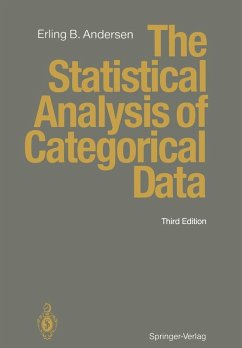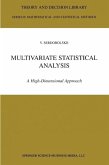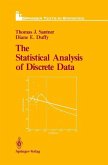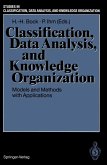Erling B. Andersen
The Statistical Analysis of Categorical Data (eBook, PDF)
40,95 €
40,95 €
inkl. MwSt.
Sofort per Download lieferbar

20 °P sammeln
40,95 €
Als Download kaufen

40,95 €
inkl. MwSt.
Sofort per Download lieferbar

20 °P sammeln
Jetzt verschenken
Alle Infos zum eBook verschenken
40,95 €
inkl. MwSt.
Sofort per Download lieferbar
Alle Infos zum eBook verschenken

20 °P sammeln
Erling B. Andersen
The Statistical Analysis of Categorical Data (eBook, PDF)
- Format: PDF
- Merkliste
- Auf die Merkliste
- Bewerten Bewerten
- Teilen
- Produkt teilen
- Produkterinnerung
- Produkterinnerung

Bitte loggen Sie sich zunächst in Ihr Kundenkonto ein oder registrieren Sie sich bei
bücher.de, um das eBook-Abo tolino select nutzen zu können.
Hier können Sie sich einloggen
Hier können Sie sich einloggen
Sie sind bereits eingeloggt. Klicken Sie auf 2. tolino select Abo, um fortzufahren.

Bitte loggen Sie sich zunächst in Ihr Kundenkonto ein oder registrieren Sie sich bei bücher.de, um das eBook-Abo tolino select nutzen zu können.
The book introduces readers to the latest developments in categorical data analysis. It shows how real life data can be analysed, how conclusions are drawn and how models are modified.
- Geräte: PC
- ohne Kopierschutz
- eBook Hilfe
- Größe: 42.25MB
Andere Kunden interessierten sich auch für
![Statistical Analysis of Extreme Values (eBook, PDF) Statistical Analysis of Extreme Values (eBook, PDF)]() Rolf-Dieter ReissStatistical Analysis of Extreme Values (eBook, PDF)64,95 €
Rolf-Dieter ReissStatistical Analysis of Extreme Values (eBook, PDF)64,95 €![Multivariate Statistical Analysis (eBook, PDF) Multivariate Statistical Analysis (eBook, PDF)]() V. I. SerdobolskiiMultivariate Statistical Analysis (eBook, PDF)72,95 €
V. I. SerdobolskiiMultivariate Statistical Analysis (eBook, PDF)72,95 €![COMPSTAT (eBook, PDF) COMPSTAT (eBook, PDF)]() COMPSTAT (eBook, PDF)72,95 €
COMPSTAT (eBook, PDF)72,95 €![Bayesian Analysis in Statistics and Econometrics (eBook, PDF) Bayesian Analysis in Statistics and Econometrics (eBook, PDF)]() Bayesian Analysis in Statistics and Econometrics (eBook, PDF)72,95 €
Bayesian Analysis in Statistics and Econometrics (eBook, PDF)72,95 €![The Statistical Analysis of Discrete Data (eBook, PDF) The Statistical Analysis of Discrete Data (eBook, PDF)]() Thomas J. SantnerThe Statistical Analysis of Discrete Data (eBook, PDF)40,95 €
Thomas J. SantnerThe Statistical Analysis of Discrete Data (eBook, PDF)40,95 €![Classification and Data Analysis (eBook, PDF) Classification and Data Analysis (eBook, PDF)]() Classification and Data Analysis (eBook, PDF)72,95 €
Classification and Data Analysis (eBook, PDF)72,95 €![Classification, Data Analysis, and Knowledge Organization (eBook, PDF) Classification, Data Analysis, and Knowledge Organization (eBook, PDF)]() Classification, Data Analysis, and Knowledge Organization (eBook, PDF)40,95 €
Classification, Data Analysis, and Knowledge Organization (eBook, PDF)40,95 €-
-
-
The book introduces readers to the latest developments in categorical data analysis. It shows how real life data can be analysed, how conclusions are drawn and how models are modified.
Dieser Download kann aus rechtlichen Gründen nur mit Rechnungsadresse in A, B, BG, CY, CZ, D, DK, EW, E, FIN, F, GR, HR, H, IRL, I, LT, L, LR, M, NL, PL, P, R, S, SLO, SK ausgeliefert werden.
Produktdetails
- Produktdetails
- Verlag: Springer Berlin Heidelberg
- Seitenzahl: 532
- Erscheinungstermin: 6. Dezember 2012
- Englisch
- ISBN-13: 9783642788178
- Artikelnr.: 53106587
- Verlag: Springer Berlin Heidelberg
- Seitenzahl: 532
- Erscheinungstermin: 6. Dezember 2012
- Englisch
- ISBN-13: 9783642788178
- Artikelnr.: 53106587
- Herstellerkennzeichnung Die Herstellerinformationen sind derzeit nicht verfügbar.
1. Categorical Data.- 2. Preliminaries.- 2.1 Statistical models.- 2.2 Estimation.- 2.3 Testing statistical hypotheses.- 2.4 Checking the model.- 3. Statistical Inference.- 3.1 Log-linear models.- 3.2 The one-dimensional case.- 3.3 The multi-dimensional case.- 3.4 Testing composite hypotheses.- 3.5 The parametric multinomial distribution.- 3.6 Generalized linear models.- 3.7 Solution of likelihood equations.- 3.8 Exercises.- 4. Two-way Contingency Tables.- 4.1 Three models.- 4.2 The 2×2 table.- 4.3 The log-linear parameterization.- 4.4 The hypothesis of no interaction.- 4.5 Residual analysis.- 4.6 Exercises.- 5. Three-way Contingency Tables.- 5.1 The log-linear parameterization.- 5.2 Hypothesis in a three-way table.- 5.3 Hypothesis testing.- 5.4 Decomposition of the test statistic.- 5.5 Detection of model departures.- 5.6 Exercises.- 6. Multi-dimension Contingency Tables.- 6.1 The log-linear model.- 6.2 Interpretation of log-linear models.- 6.3 Search for a model.- 6.4 Diagnostics for model departures.- 6.5 Exercises.- 7. Incomplete Tables, Separability and Collapsibility.- 7.1 Incomplete tables.- 7.2 Two-way tables and quasi-independence.- 7.3 Higher order tables. Separability.- 7.4 Collapsibility.- 7.5 Exercises.- 8. The Logit Model.- 8.1 The logit-model with binary explanatory variables.- 8.2 The logit model with polytomous explanatory variables.- 8.3 Exercises.- 9. Logistic Regression Analysis.- 9.1 The logistic regression model.- 9.2 Regression diagnostics.- 9.3 Predictions.- 9.4 Polytomous response variables.- 9.5 Exercises.- 10. Models for the Interactions.- 10.1 Introduction.- 10.2 Symmetry models.- 10.3 Marginal homogeneity.- 10.4 Models for mobility tables.- 10.5 Association models.- 10.6 RC-association models.- 10.7 Log-linear association models.- 10.8 Exercises.- 11. Correspondence Analysis.- 11.1 Correspondence analysis for two-way tables.- 11.2 Correspondence analysis for multi-way tables.- 11.3 Comparison of models.- 11.4 Exercises.- 12. Latent Structure Analysis.- 12.1 Latent structure models.- 12.2 Latent class models.- 12.3 Continuous latent structure models.- 12.4 The EM-algorithm.- 12.5 Estimation in the latent class model.- 12.6 Estimation in the continuous latent structure model.- 12.7 Testing the goodness of fit.- 12.8 Diagnostics.- 12.9 Score models with varying discriminating powers.- 12.10 Comparison of latent structure models.- 12.11 Estimation of the latent variable.- 12.12 Exercises.- 13. Computer Programs.- References.- Author Index.- Examples with Data.
1. Categorical Data.- 2. Preliminaries.- 2.1 Statistical models.- 2.2 Estimation.- 2.3 Testing statistical hypotheses.- 2.4 Checking the model.- 3. Statistical Inference.- 3.1 Log-linear models.- 3.2 The one-dimensional case.- 3.3 The multi-dimensional case.- 3.4 Testing composite hypotheses.- 3.5 The parametric multinomial distribution.- 3.6 Generalized linear models.- 3.7 Solution of likelihood equations.- 3.8 Exercises.- 4. Two-way Contingency Tables.- 4.1 Three models.- 4.2 The 2×2 table.- 4.3 The log-linear parameterization.- 4.4 The hypothesis of no interaction.- 4.5 Residual analysis.- 4.6 Exercises.- 5. Three-way Contingency Tables.- 5.1 The log-linear parameterization.- 5.2 Hypothesis in a three-way table.- 5.3 Hypothesis testing.- 5.4 Decomposition of the test statistic.- 5.5 Detection of model departures.- 5.6 Exercises.- 6. Multi-dimension Contingency Tables.- 6.1 The log-linear model.- 6.2 Interpretation of log-linear models.- 6.3 Search for a model.- 6.4 Diagnostics for model departures.- 6.5 Exercises.- 7. Incomplete Tables, Separability and Collapsibility.- 7.1 Incomplete tables.- 7.2 Two-way tables and quasi-independence.- 7.3 Higher order tables. Separability.- 7.4 Collapsibility.- 7.5 Exercises.- 8. The Logit Model.- 8.1 The logit-model with binary explanatory variables.- 8.2 The logit model with polytomous explanatory variables.- 8.3 Exercises.- 9. Logistic Regression Analysis.- 9.1 The logistic regression model.- 9.2 Regression diagnostics.- 9.3 Predictions.- 9.4 Polytomous response variables.- 9.5 Exercises.- 10. Models for the Interactions.- 10.1 Introduction.- 10.2 Symmetry models.- 10.3 Marginal homogeneity.- 10.4 Models for mobility tables.- 10.5 Association models.- 10.6 RC-association models.- 10.7 Log-linear association models.- 10.8 Exercises.- 11. Correspondence Analysis.- 11.1 Correspondence analysis for two-way tables.- 11.2 Correspondence analysis for multi-way tables.- 11.3 Comparison of models.- 11.4 Exercises.- 12. Latent Structure Analysis.- 12.1 Latent structure models.- 12.2 Latent class models.- 12.3 Continuous latent structure models.- 12.4 The EM-algorithm.- 12.5 Estimation in the latent class model.- 12.6 Estimation in the continuous latent structure model.- 12.7 Testing the goodness of fit.- 12.8 Diagnostics.- 12.9 Score models with varying discriminating powers.- 12.10 Comparison of latent structure models.- 12.11 Estimation of the latent variable.- 12.12 Exercises.- 13. Computer Programs.- References.- Author Index.- Examples with Data.







